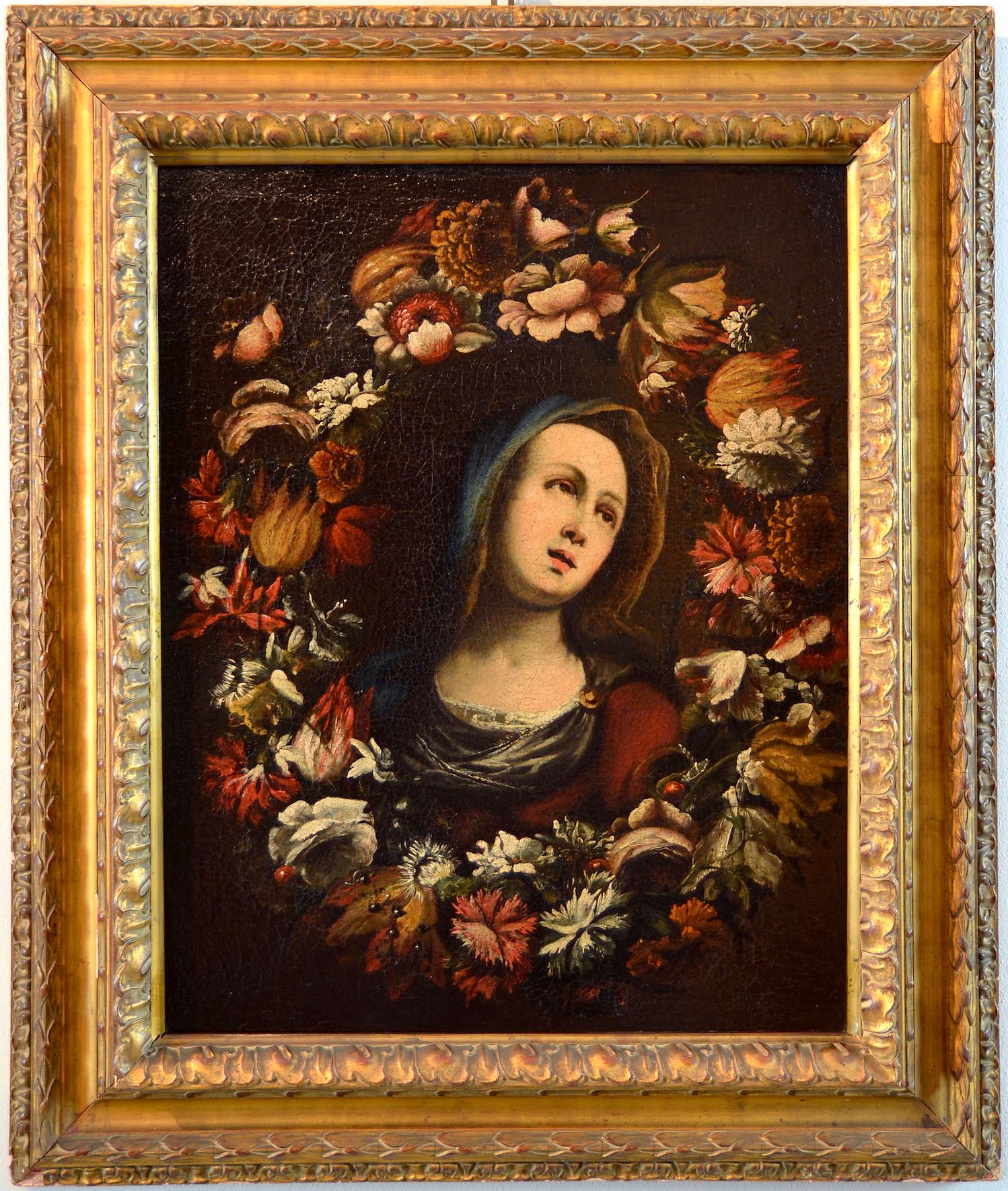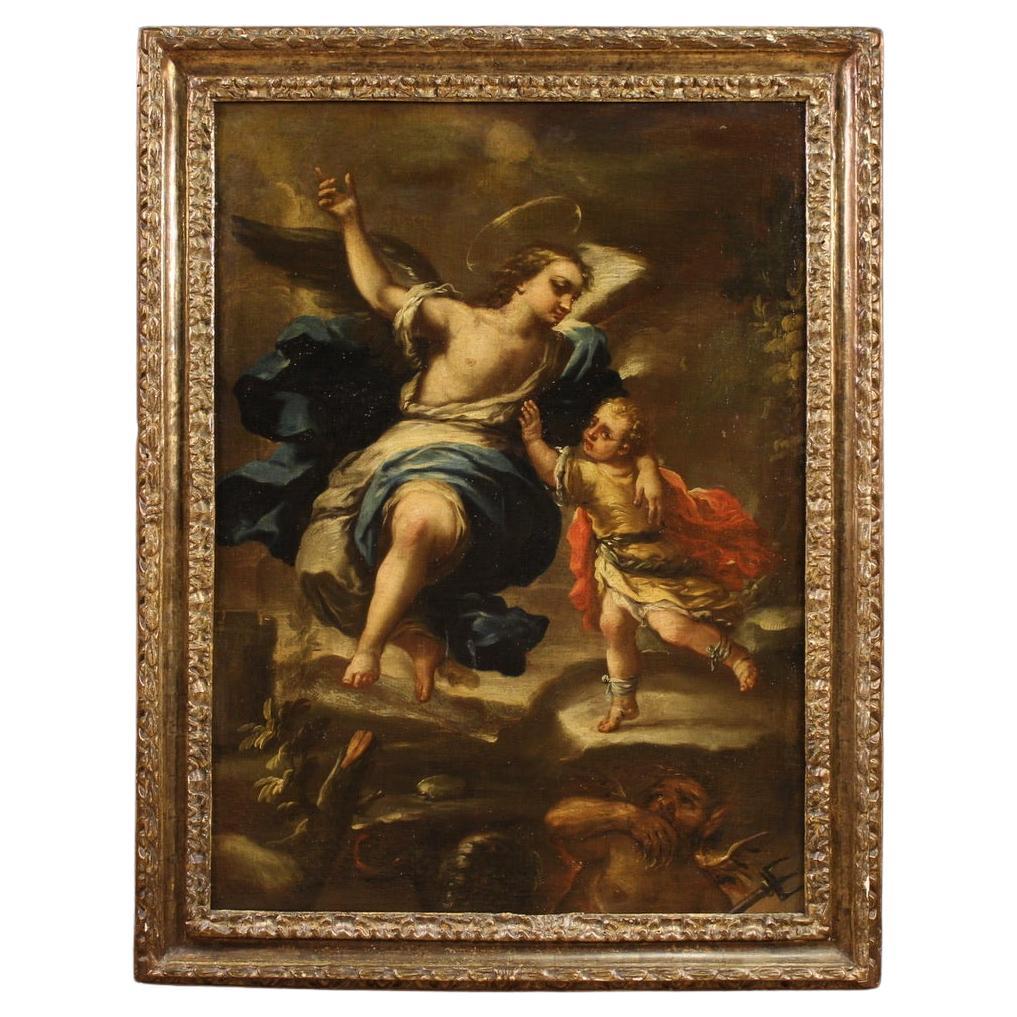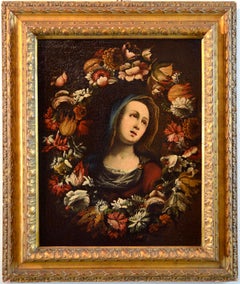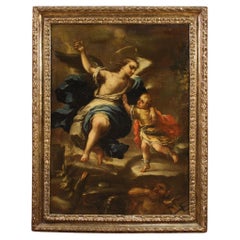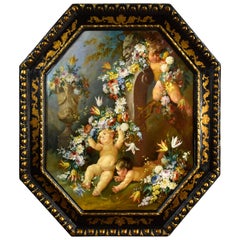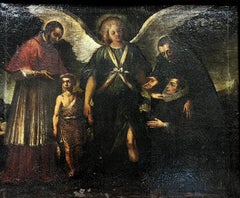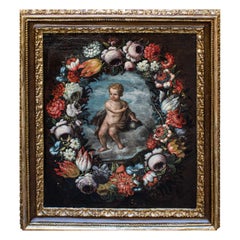Items Similar to Angels Floral Garland Maratta Paint Oil on table Old master 17th Century Italian
Want more images or videos?
Request additional images or videos from the seller
1 of 22
Angels Floral Garland Maratta Paint Oil on table Old master 17th Century Italian1697
1697
$9,843.95
$13,239.4925% Off
£7,328.18
£9,855.9425% Off
€8,216
€11,05025% Off
CA$13,483.75
CA$18,134.7925% Off
A$14,996.87
A$20,169.8425% Off
CHF 7,830.90
CHF 10,532.0625% Off
MX$182,495.96
MX$245,445.5225% Off
NOK 100,012.54
NOK 134,510.5425% Off
SEK 93,794.12
SEK 126,147.1525% Off
DKK 62,545.54
DKK 84,119.7925% Off
Shipping
Retrieving quote...The 1stDibs Promise:
Authenticity Guarantee,
Money-Back Guarantee,
24-Hour Cancellation
About the Item
Pair of angels with floral garland and cartouche with family motto 'Pulchriora latent'
Workshop of Carlo Maratta (Camerano, 1625 - Rome, 1713)
Dated on parchment, right: 1697
oil on the table (94 x 84cm./ in frame 105 x 95 cm.)
This magnificent composition, depicting two little fluttering cupids intent on holding up a garland of flowers, can be traced back, both for the stylistic characteristics and for the compositional taste, to a master active in the fervid seventeenth-century Baroque Rome.
One of the two cupids is about to grab the bow of the garland with his head facing downwards, while with the other hand he shows a parchment which bears, in addition to the date of execution, the Latin expression "Pulchriora latent" ("The the most beautiful things are hidden"), which could probably recall the motto of the commissioning family. A second winged putto, perched on a cloud, watches the scene clutching the other end of the garland, richly decorated with various types of flowers, enriching the composition with a piece of still life of excellent quality.
The iconography that sees putti with flowers represented is frequent in the Baroque period, especially in Rome, congenial to the new bourgeois class, who wanted more illusionistic and frivolous images for their residences, and therefore aspired to a type of paintings with a strong decorative value , depicting jubilation of cherubs, angels or cherubs, and of which our table represents an emblematic example.
Going into the detail of the composition, his design invention as well as the stupendous lighting and chromatic effects lead us to link his authorship to the inventive flair of the workshop of Carlo Maratta (1625 - 1713). Note how the soft roundness of the playful cherubs, the brushstroke that defines the flowing hair and their soft complexions, are characteristic elements of his art.
In particular, it is useful to recall the series of paintings commissioned in 1692 by the banker Francesco Montioni for his palace in Rome (Opere di palazzo Montioni, Rome: link), and which Maratta himself executed with the collaboration of his pupil Franz Werner von Tamm (1658-1724). Again in collaboration with Tamm, Carlo Maratta repeated these compositions for the Marquis Nicolò Maria Pallavicini.
This still life iconography immediately found an echo among Roman collectors, and was therefore replicated and varied on numerous occasions. Among these the 'Garland of flowers with cupids' (Sotheby's, London, 6 July 1994, n. 115), finds correspondences with our painting:
A particularity that makes this work unique is that the panel is also painted on the back with two vertical ornaments with acanthus leaf motifs, which seem to have been carved in the 'trompe l'oeil' style. One could assume their original function as doors for a chamber organ.
Excellent state of conservation.
ADDITIONAL INFORMATION:
The work is sold with a certificate of authenticity and a descriptive iconographic sheet.
We take care of and organize the transport of the purchased works, both for Italy and abroad, through professional and insured carriers.
It is also possible to see the painting in the Riva del Garda gallery, we will be happy to welcome you to show you our collection of works.
Contact us, without obligation, for any additional information.
- Creation Year:1697
- Dimensions:Height: 41.34 in (105 cm)Width: 37.41 in (95 cm)
- Medium:
- Movement & Style:
- Circle Of:Carlo Maratta (Camerano, 1625 - Rome, 1713) (1625 - 1713)
- Period:
- Condition:
- Gallery Location:Riva del Garda, IT
- Reference Number:1stDibs: LU988111526872
About the Seller
4.9
Platinum Seller
Premium sellers with a 4.7+ rating and 24-hour response times
Established in 2017
1stDibs seller since 2018
255 sales on 1stDibs
Typical response time: <1 hour
- ShippingRetrieving quote...Shipping from: Riva del Garda, Italy
- Return Policy
Authenticity Guarantee
In the unlikely event there’s an issue with an item’s authenticity, contact us within 1 year for a full refund. DetailsMoney-Back Guarantee
If your item is not as described, is damaged in transit, or does not arrive, contact us within 7 days for a full refund. Details24-Hour Cancellation
You have a 24-hour grace period in which to reconsider your purchase, with no questions asked.Vetted Professional Sellers
Our world-class sellers must adhere to strict standards for service and quality, maintaining the integrity of our listings.Price-Match Guarantee
If you find that a seller listed the same item for a lower price elsewhere, we’ll match it.Trusted Global Delivery
Our best-in-class carrier network provides specialized shipping options worldwide, including custom delivery.More From This Seller
View AllAngels Flower Garzi Paint Oil on canvas Old master 17/18th Century Italian Art
By Luigi Garzi (Pistoia 1638– Rome1721)
Located in Riva del Garda, IT
Roman school of the early 18th century
Luigi Garzi (Pistoia 1638– Rome1721) attributed
Still life of fruit supported by three angels
Oil on oval canvas
116 x 91 cm., Framed 140 x 119 cm.
Authentication on a photograph by Prof Giancarlo Sestieri, who attributes the work to the sphere of Luigi Garzi
This magnificent canvas, depicting a sumptuous composition of fruit supported by three prosperous winged cherubs, from which comes a parchment bearing the Latin expression "Amor est vitae essentia", is to be placed in the production of a Roman author active between the second half of XVII century and the first of the following century.
The iconography that sees represented cherubs with fruit or flowers is frequent in the Baroque period, especially in the Roman area, starting from the 1600s, with that particular depictional tendency aimed at illusionistic and frivolous images, to a type of paintings or frescoes of strong value decorative, intended for the private context and depicting jubilation of cherubs, angels or cherubs, and of which our canvas represents a perfect example.
We can recall, among the most illustrious iconographic precedents, the elegant mirrors painted by Mario Nuzzi and Carlo Maratta that adorn the hall of Palazzo Colonna in Rome, and again the canvas preserved in the Rouen museum and the similar ones in Palazzo Chigi in Ariccia, with the collaboration for the figurative parts of Filippo Lauri.
The commercial and furnishing success of similar works is also testified by authors such as Guglielmo Cortese known as Borgognone (1628 - 1679), Franz Werner Von Tamm (1658 - 1724), Giovan Battista Gaulli (1639 - 1709), Giovanni Paolo Castelli known as Spadino (Rome 1650 - 1740) and the aforementioned Carlo Maratta (1625 - 1713)
The work, studied by Giancarlo Sestieri, was brought closer to the sphere of the eclectic Pistoian painter Luigi Garzi, one of the protagonists of Roman painting in the decades of transition between the seventeenth and eighteenth centuries. In our painting we can find the typical elements of his painting: the soft and delicately chiaroscuro light, the sculptural classicism of the figures as well as the stupendous luministic and chromatic effects.
Luigi Garzi's training and artistic activity took place in the Eternal City and he was in effect a Roman artist. He moved to Rome from Pistoia, his hometown at a very young age, and joined the atelier of Andrea Sacchi, who directed his studies towards classicism, comparing himself with the works of Raphael, Domenichino and Nicolas Poussin, but also with the Emilian one. , with particular attention to the school of Guido Reni.
But the Emilian examples were undoubtedly preceded, particularly by Giovani Lanfranco, who modeled his taste and style, together with a modulated cortonism, while those pre-eighteenth-century sensibilities are due to the lesson of Carlo Maratta.
However, there is no doubt that the painter oriented his personality without ever bowing to imitation, reaching a refined elegance and autonomy of language, as the canvas in question clearly demonstrates in which the different influences find a refined amalgamation in perfect harmony with the baroque evolution between the seventeenth and eighteenth centuries, indicating a dating to its earliest maturity.
These attitudes led the painter to obtain awards and prestigious commissions as soon as possible, such as the frescoes of Palazzo Borghese...
Category
Late 17th Century Old Masters Paintings
Materials
Oil
$14,952 Sale Price
20% Off
Flower Garland Virgin Paint Oil on canvas Old master 17th Century Italy
By Giovanni Stanchi
Located in Riva del Garda, IT
Giovanni Stanchi (Rome 1608 - 1675) or Niccolò Stanchi (Rome 1623 - 1690), workshop of
GARLAND OF FLOWERS WITH PORTRAIT OF THE VIRGIN
Rome, First half of the Seventeenth century
o...
Category
17th Century Old Masters Paintings
Materials
Oil
$5,559 Sale Price
20% Off
Flowers Paint Oil on canvas Old master 17th Century Italy Still-life Art
Located in Riva del Garda, IT
Master of the Grotesque Vase (active in Rome and Naples in the first quarter of the 17th century)
Still life of flowers in a classic vase
oil on canvas
66 x 51 cm, In frame cm. 82 x...
Category
17th Century Old Masters Paintings
Materials
Oil
$8,348 Sale Price
20% Off
Christ Angels Pietro Da Cortona Paint Oil on canvas Old master 17th Century Art
Located in Riva del Garda, IT
Christ surrounded by angels in the desert
Circle of Pietro da Cortona, born as Pietro Berrettini (Cortona 1597 - Rome 1669)
Oils on canvas (66 x 50 cm. - in frame 80 x 64 cm.)
The ...
Category
17th Century Old Masters Paintings
Materials
Oil
$8,597 Sale Price
20% Off
Announcing Angel Gabriel Maratta 17th Century Paint Oil on canvas Old master
Located in Riva del Garda, IT
The Announcing Angel Carlo Maratta (Camerano, 1625 – Rome, 1713)Workshop
Oil on canvas 63 x 75 cm. - Gilded wood frame 89 x 75 cm.
Excellent condition, restored, 19th century ...
Category
17th Century Old Masters Paintings
Materials
Oil
$9,594 Sale Price
20% Off
De Wit Flowers Still life Paint Oil on canvas 18th Century Flemish Cupids Art
Located in Riva del Garda, IT
Jacob De Wit (Amsterdam, 1695 - 1754) attributable/ workshop
Pair of Cupids with Garland of Flowers
Oil on canvas
91 x 103 cm. - Framed 104 x 115 cm.
Provenance: Christie's (London, Old master Painting 12.12.1996) lot 82
This magnificent composition depicts two cupids holding a garland of flowers, placed on a fine architecture with bas-reliefs and masks, presumably the top of a fountain.
One of the two cupids sympathetically holds a part of it with his hands, while his head turns towards the viewer; the second cupid, on the other hand, must have clumsily broken the thread holding its end, and is sitting sullenly with a torch and a tear streaking his chubby cheek.
The work, given its stylistic features and compositional taste, can be attributed to the Flemish artist Jacob de Wit (Amsterdam, 1695 - 1754), or to an artist from his workshop, with his typical triumphal and opulent style, which reveals clear influences from Rubens and Van Dijck, but also from Gerard de Lairesse...
Category
18th Century Old Masters Paintings
Materials
Oil
$14,952 Sale Price
20% Off
You May Also Like
17th Century Oil on Canvas Italian Biblical Painting Tobias And The Angel, 1660
Located in Vicoforte, Piedmont
Wonderful 17th century Italian painting. Oil on canvas artwork depicting Tobias and the angel Raphael, a famous biblical episode from the Book of Tobit. In the story, the young Tobia...
Category
Antique 1660s Italian Paintings
Materials
Canvas
19th Century, Italian Painting with Still Life with Cherubs
Located in IT
19th century Roman painter
Still life with cherubs, flower festoons and herma with faun
Measures: Oil on canvas, cm H 78 x W 95 without frame
Cm H 122.00 x W 106 x D 8 with frame.
The work, painted in oil on canvas, octagonal in shape, represents a nature with three putti or cupids playing with flower festoons in a wooded environment in which is placed a herma with faun and, on the left, a large neoclassical marble vase...
Category
Antique 19th Century Italian Baroque Paintings
Materials
Canvas
Fine Italian Old Master Oil Painting Angel & Saints Appearing to Figures
Located in Cirencester, Gloucestershire
Artist/ School: Italian Old Master, 18th century
Title: Angel and Saints appearing to figures, one dressed in a white ruff collar.
Medium: oil on canvas...
Category
Early 18th Century Old Masters Figurative Paintings
Materials
Canvas, Oil
Oil on canvas Jesus child within garland of flowers 18th century
Located in Milan, IT
Lombard School, 17th century
Christ child with globe within garland of flowers
Oil on canvas, 72 x 61 cm
Framed 90, 5 x 80
The present painting, framed by a sumptuous antique fr...
Category
Antique 18th Century Paintings
Materials
Canvas
Angelic Cherubs with Classical Figure in Wilderness Finely Painted Preparatory
Located in Cirencester, Gloucestershire
Figure with Cherubim in Wilderness
Italian School, 17th century
oil painting on wood panel
framed 13 x 11 inches
condition: overall for its age very good, though the work is most likely a preparatory...
Category
17th Century Old Masters Figurative Paintings
Materials
Oil, Wood Panel
17th-18th Century Venetian Painting
Located in Pembroke, MA
Venetian School painting of four angels, allegorically depicting the variable winds of change and time. Unsigned, believed to be by a follower of Pietro Li...
Category
Antique 17th Century Italian Baroque Paintings
Materials
Giltwood, Canvas
$9,500 Sale Price
39% Off
More Ways To Browse
Oil Paintings Rome
Old Flower Painting
Old Master Painting Italian
Old Painting Oil On Panel
Italian Floral Painting
Italian Painting Angel
Table With Angels
Old Master Flower Painting
17th Century Painted Panels
Antique Inventions
Antique Round Painting
Palace Door
Wanted Antique Paintings
Pair Of Angels
Italian Antique Angels
Oil On Panel 17th Century
Antique Motto
Cherub Panel
